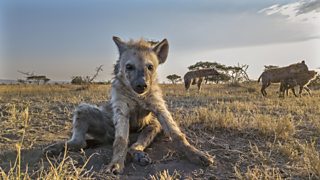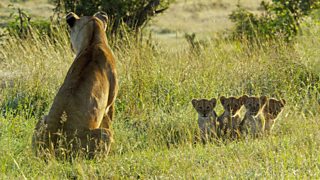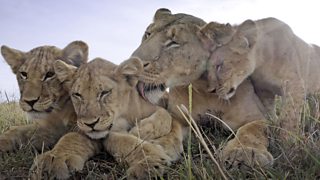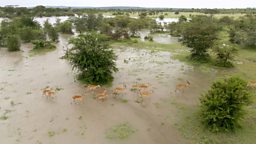How We Made Serengeti
By Series Director John Downer

Serengeti is a dramatised Natural History series based on the real behaviour of the animals that live in this spectacular part of East Africa. Its aim is to reveal the intimate details of family life using immersive filming techniques and a style of narration that illuminates their daily struggles from a first-person viewpoint. All the stories reflect their real behaviour and are faithful to the known biology of the animals featured. Where possible, the same animals are filmed throughout and a character’s storyline may require a year of dedicated filming to capture every stage of their lifecycle. Occasionally, especially among fast moving herd animals, such dedicated filming isn’t possible, so in those cases we may combine the stories of different individuals to form a seamless narrative that reflects and illuminates the true story of how they lead their lives.
Before filming begins, a story plan is created based on the known behaviour of the animals and the likely events that may naturally occur over the filming period. This story plan is constantly revised and modified as the filming crews start to capture both the expected behaviour, as well as surprising moments that could never have been anticipated. As the unexpected events outnumber the expected, there comes a point where the animals are effectively writing their own story. Our job then becomes a matter of structuring their different stories into a coherent narrative that reflects the drama of their everyday lives and the intertwined nature of their relationships.
The names chosen to represent our animal characters are all based on Swahili, the prime language of the region. Sometimes it is a simple translation, for example, “Duma” means cheetah and “Tembo” means elephant but we also used local names that have meaning: “Bakari” for “someone who will succeed” seemed perfect for everyone’s favourite baboon, while “Nalla”, the elephant matriarch, suggests “someone who has achieved everything”. Lastly, we used Swahili words that match an animal’s character. The name given to “Kali” the lioness means fierce, while “Tamu”, the doe-eyed gazelle fawn’s name translates as sweet.

To tell these incredible stories in such intimate detail the film crews had to earn the trust of their subjects and spend hundreds of hours among them. The crew and cameras became effectively invisible to the animals they filmed – often the cameras were just a whisker away while they carried on with everyday lives. Every member of the filming team has many years of experience filming African animals; for many, this spans over 30 years. Their fieldcraft and knowledge of animal behaviour meant they could anticipate many of the events before they happened, so very little was ever missed.
Filming Serengeti
Serengeti I pioneered many filming techniques to immerse the audience in the world of the animals. These innovations allowed the cameras to travel with their subjects wherever they went using revolutionary stabilised camera systems, drones and also “Spy” camera techniques. Serengeti II built on this pioneering work using a new generation of specialist cameras so that each of the filming teams could also deploy an army of remote cameras into the field, ensuring every possible angle was covered.

Much of this footage was captured when none of the crew were around. The cameras were triggered by the activity of our subjects and sophisticated image recognition software filtered out false triggers caused by wind or other movement. Other cameras were mounted onto small remotely operated disguised buggies that could move freely around the animals, while being controlled by the camera team. These could drive into previously inaccessible areas, such as rocky outcrops, long grass and, for the aquatic version, the wildest rapids.
The latest drones incorporated game-changing technology, reducing size and sound levels, enabling them to capture previously unseen moments of remarkable behaviour without disturbing their subjects. This breakthrough also enabled the camera cars to operate further away, minimising disturbance even further.
With so much coverage of any event it was very rare for the series to need any archive material to help clarify moments that might have been missed. The multiple camera techniques also showed the relationship between the different species in any interaction. Very occasionally shots of the characters involved were composited together to make this clearer. But such was the coverage, this technique was rarely needed. In addition to all of this, each crew vehicle carried the latest stabilised 8K camera systems able to film on the move with ultra-telephoto zooms. Combined with newly designed vibration-damping arms, the crew could film while driving over the most extreme terrain, in all weather, while maintaining a steady shot even on the end of the longest zoom lens.
The series’ dramatic style creates an opportunity to tell a compelling story that presents a rounded, comprehensive and empathetic view of the animals that make up the Serengeti ecosystem. It highlights the interconnected nature of their lives and how one event impacts on the lives of others. With intimate in-the-animal-world photography and the use of dramatised storytelling techniques it has been possible to explore the emotional bonds that tie families together and the fears, ambitions and motivations that drive their behaviour.
The Flood
The flood seen in Serengeti II was a once rare event that is likely to become more common due to climate change. A phenomenon known as an “extreme positive Indian Ocean Dipole” in the second half of 2019, led to unprecedented rainfall and flooding in east Africa during 2020. At the same time, it caused the extreme drought and wildfires in Australia.
In 2019-2020 the dipole was over two times its normal intensity and east Africa experienced twice its normal level of rainfall. These extreme fluctuations are predicted to happen more frequently in the years to come due to human-caused climate change.

- The crew managed to film throughout these extreme weather events, capturing the Serengeti cast as they struggled to escape the never-ending floods.
- The constant deluges made for challenging filming conditions: filming cars were constantly stuck in the mud, camera equipment malfunctioned in the wet weather, and roads and bridges were washed away in an instant.
- Despite the challenges, the crew’s perseverance allowed them to capture some extraordinary behaviour, from Bakari leaping from his flooded tree and Gnu getting lost in a thunderstorm, to Punda racing to save Shani as she was washed downstream.
